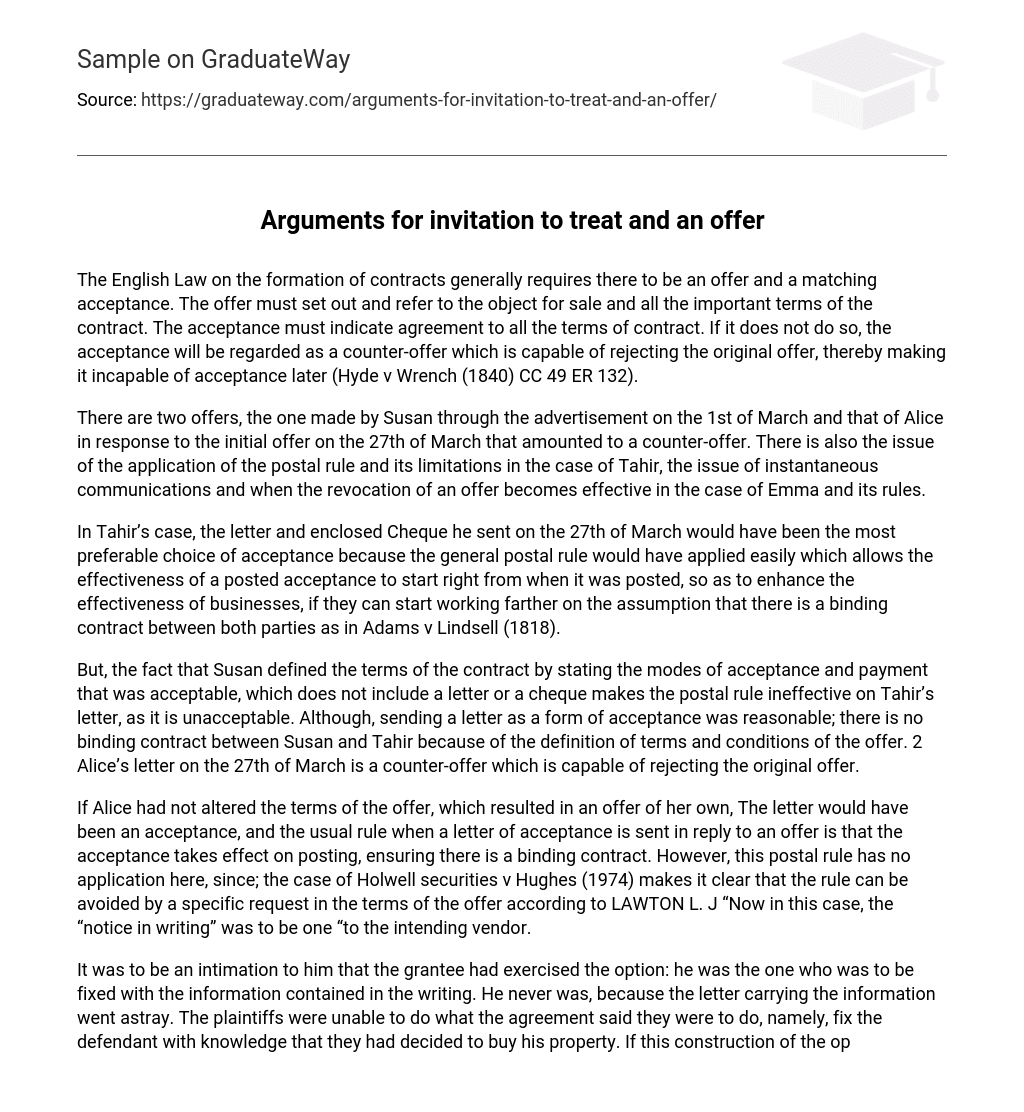According to English Law, contracts are formed through a process involving an offer and acceptance. For a valid offer, it is necessary for the object for sale and all important contract terms to be clearly stated. The acceptance of the offer must indicate agreement to all the terms of the contract. Failure to do so will result in the acceptance being treated as a counter-offer, which can reject the original offer and render it unacceptabllater (Hyde v Wrench (1840) CC 49 ER 132).
On the 1st of March, Susan made an offer through an advertisement. On the 27th of March, Alice responded to Susan’s offer with a counter-offer. Additionally, we need to consider the application of the postal rule and its limitations in Tahir’s case. Furthermore, we need to understand the rules regarding instantaneous communications and when the revocation of an offer becomes effective in Emma’s case.
In Tahir’s situation, the letter and accompanying Cheque that he sent on March 27th would have been the preferred method of accepting the offer. This is because the general postal rule would have been applicable, which states that a posted acceptance is effective from the moment it is sent. This rule exists to facilitate business transactions, allowing them to proceed on the assumption that a binding contract has been established between the parties involved, as demonstrated in the case of Adams v Lindsell (1818).
Despite the reasonableness of Tahir sending a letter as a form of acceptance, the postal rule is rendered ineffective in this case because Susan explicitly defined the acceptable modes of acceptance and payment, which does not include a letter or a cheque. As a result, there is no binding contract between Susan and Tahir due to the terms and conditions defined in the offer. Furthermore, Alice’s letter on March 27th acts as a counter-offer and has the potential to reject the original offer.
If Alice had not changed the terms of the offer, leading to her own offer, the letter would have been considered an acceptance. Under normal circumstances, when a letter of acceptance is sent in response to an offer, it takes effect upon being posted, creating a legally binding contract. However, in this situation, the postal rule does not apply due to the case of Holwell securities v Hughes (1974). This case clarifies that the rule can be avoided if there is a specific request in the terms of the offer. As LAWTON L. J stated, “Now in this case, the ‘notice in writing’ was to be one ‘to the intending vendor.'”
The purpose of the writing was to inform him that the grantee chose to exercise the option, but he never received this information because the letter containing it was lost. As a result, the plaintiffs couldn’t fulfill their obligation to notify the defendant of their decision to purchase his property as agreed. If this interpretation of the option clause is correct, then there’s no need for any legal rule regarding mail acceptance since the agreement specified the necessary steps to exercise the option.
On this ground alone I would dismiss the appeal. Considering, the email Alice sent on the 28th of March, which would have been the most suitable form of acceptance as at that time, although it was sent on Friday, it was out of office hours and so Susan is unable to read it, therefore the acceptance was not communicated as the instantaneous communications rules requires as in Entores v Miles East Corp. It is generally agreed that the instantaneous communications will cover the email, and so the time of communication, rather than the time of sending, is the relevant time.
According to the rule, applying it to Alice’s email would have no impact as the offer was no longer valid when it was communicated. Therefore, Alice and Susan do not have a legally binding contract because Alice’s email was a counter-offer sent after the offer had been withdrawn. Legal precedents show that offers can be withdrawn before acceptance, as long as the withdrawal is communicated to the person receiving the offer (Payne v Cave, 1789).
The text suggests that the revocation of an offer by telegram was addressed in the case of Byrne v Van Tienhoven (1880). In relation to Emma and Susan’s dealings, if Susan received Emma’s email before the revocation was published in the papers, the revocation would not be effective and a binding contract would exist. It is assumed that the advert is considered communicated to Emma once it was published and available on March 29th. This assumption is based on the fact that the information in the advert notifies Emma that Susan has withdrawn the offer. However, Emma may argue that the offer was open until March 31st, giving them a binding contract. This argument is not valid according to the case of Routledge v Grant (1828), where it was established that a promise of this nature is generally not binding due to lack of consideration provided by the promise.
If Susan had received compensation for extending the offer until March 31st, she would have been obliged to honor her commitment. However, since there was no such compensation offered, she is within her rights to withdraw the offer at any point. Consequently, Emma’s email is irrelevant as Susan has already communicated the withdrawal through a published notice, which is the most reasonable method. Therefore, there is no legally binding agreement between Susan and the other parties.





